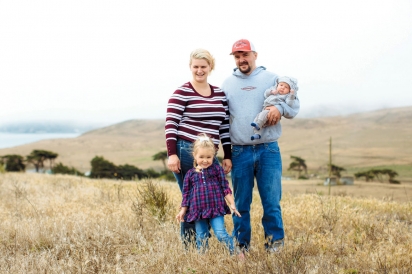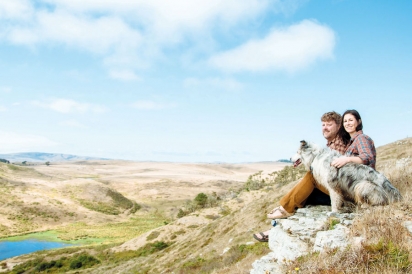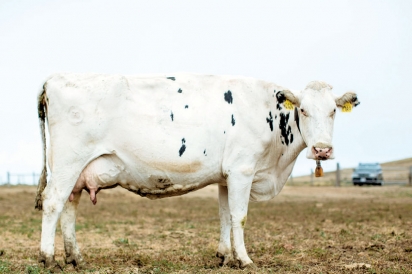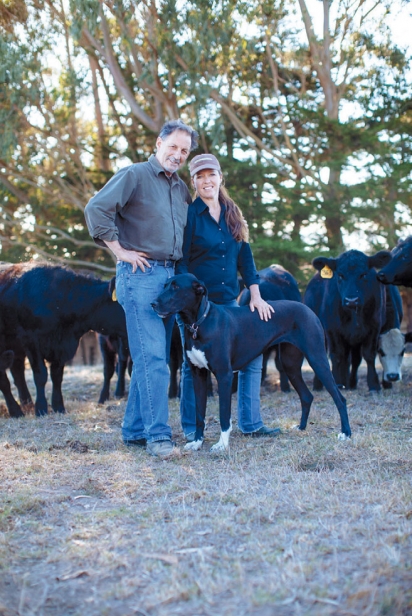Ranching in Point Reyes National Seashore Called into Question
Lawsuit Challenges the Future of Small-Scale Livestock Production at Point Reyes National Seashore
If you follow Sir Francis Drake Boulevard down the Point Reyes Peninsula toward the lighthouse, beyond the now-vacated Drakes Estero, you might find yourself at Historic Ranch B, also known as Double M Dairy. Here, Jarrod Mendoza raises dairy cows on land his family has ranched for generations.
Despite its sweeping views and windswept vistas, the 1,200-acre ranch isn’t large by today’s standards. The certified organic milk from the 250 cows Mendoza manages usually only fills half of the refrigerated storage tank that is kept in a low-ceilinged room beside the milking parlor. When Jarrod’s father, Joey, ran the ranch using conventional methods, he grazed 500 cows at a time, and the tank was always full. Now, Mendoza sells his organic milk to Straus Family Creamery. The move to higher-priced organic has allowed him to produce less and give each animal access to more pasture during the winter and spring when seasonal rains bring the grass on his land to life.
In 2011, when Mendoza, fresh out of college, took over the nearly 100-yearold farm and bought a certified organic herd, his father remarked at how similar the new approach was to the way his own father, Jerrod’s grandfather, had done things. Mendoza took that as a good sign. And although he maintains ties with many of his father’s friends—conventional dairymen to the north and south of his ranch—he decided their approach wasn’t for him. “It’s just a very different system,” he says. “They try to get as much out of each animal as they can.”
When Mendoza and his wife, Kayla, first moved back to the ranch, the isolated location was familiar to him, but that didn’t make it easy. “You have to make sure when you go to town to get supplies that you make it worth it every time,” he says. “I grew up here, but it took Kayla a while to get used to it.” And while the coastal wind and fog aren’t always the most hospitable, he says, “I can’t think of a better place for a dairy operation than out here. This is cow weather.”
Mendoza’s is just one of six organic dairy farms in the Point Reyes National Seashore, where there are a total of 22 families running 27 ranches. Their presence pre-dates the area’s designation in 1962 as a national park. For decades, the families coexisted beside one another, borrowing tools and supplies on occasion, calling each other when, say, one ranch’s cows managed to slip into the wrong pasture. But ranching is demanding, full-time work that often keeps one confined to his or her own land, so they haven’t always been a close-knit group.
This year, all that changed. Since February, Mendoza and the other ranchers have found themselves at the center of a legal battle that is questioning the impact their operations have on the environment and—at the core—their relationship to the national seashore. It’s a very different scenario than the one that transpired at the Drakes Bay Oyster Company just a few years ago, but the ranchers are working together and bracing for a similar, community-wide battle.
The Lawsuit
Earlier this year, three environmental groups—Center for Biological Diversity, Resource Renewal Institute and the Western Watersheds Project—filed a federal suit in an effort to require the National Park Service to update its Park-wide general management plan and prepare an environmental impact statement. While the Park Service has spent the last several years developing a Ranch Comprehensive Management Plan and environmental assessment, the three plaintiffs say it’s not enough. The groups want to see the Park Service zoom out to focus on how ranching impacts the Park as a whole, and give the public a clear, transparent sense of that impact before they create a plan for the ranches.
They also call into question a number of elements in the proposed Ranch Comprehensive Management Plan, such as the ranchers’ ongoing petitions for the allowance of more farm diversity (including row crops, poultry and other livestock) and longer leases.
“The Park Service’s most recent general management plan for the seashore is 36 years old,” says Chance Cutrano of Resource Renewal Center, a small Marin-based nonprofit run by Huey Johnson, who founded the Trust for Public Land and acted as the California Secretary of Resources during the first Jerry Brown Administration. “The [plan] doesn’t address the current challenges—the 2.5 million visitors last year, the threats to endangered and native wildlife, the impacts of climate change, nor the new normal that is drought,” says Cutrano.
“The impacts of ranching have never been assessed in an environmental statement,” he adds. “It has only been piecemeal.”
The groups are troubled by the idea that ranching is an inherent part of the Park’s landscape. “There’s an assumption—if you look at some of the signs in the Park—that ranching is here for the future,” says Cutrano.
According to the Park Service—which declined to comment on the lawsuit for this story, but provides many current and historical documents on its website—the ranchers worked with the environmental advocacy organization the Sierra Club in the 1960s to reach a compromise for the creation of the Park at a time when residential development in the area was otherwise imminent.
“The compromise hammered out by Congress and signed by President Kennedy in 1962 explicitly provided for the retention of the ranches in a designated pastoral zone, with ranchers signing 25-to 30-year reservations of use and occupancy leases, and special use permits for cattle grazing. Over the ensuing 10 years, the National Park Service acquired the 17 remaining operating ranches and the property of the abandoned ranches,” reads the Point Reyes Nation Seashore’s website.
As Cutrano mentioned, the historic five-year California drought creates a dramatic backdrop for the lawsuit, and the plaintiffs have raised some big questions about whether the livestock can coexist with wildlife in the Park at a time of diminished resources. “If water resources are strictly going to [ranches] in the Park, and if they’re pumping it up from wells, streams and retention ponds, that leaves fewer resources for wildlife,” Cutrano says.
Jeff Miller, a conservation advocate at the Center for Biological Diversity who lives in West Marin, says his national organization has been “looking at Point Reyes for the last 10–15 years.” He says the group has long had its eye on the impacts of cattle grazing to salmon and steelhead trout in the Park, but they became “especially interested” once the conflicts between the Park’s population of tule elk (a species that exists only in the Point Reyes National Seashore) and cattle grazing started coming up.
“Our lawsuit doesn’t call for an end to grazing in the Park,” says Miller. But he and the other plaintiffs worry that the proposed Ranch Comprehensive Management Plan could further institutionalize ranching in the Park and help ranchers expand their operations.
“We see the proposed expansion of ranching out there as a problem given that the Park Service doesn’t have any kind of control over the current grazing that’s going on.” Miller likens expansion to a scenario in which “people wanted to start running off-road vehicles in the Park. I’m sure there’d be a huge outcry and people would want an analysis of the impacts before a special use permit was given out.”
In the press release issued by the three plaintiffs on the filing of the lawsuit, Karen Klitz, a board member at Western Watersheds Project, added: “Behind-the-scenes negotiations between a handful of ranchers and well-meaning conservationists is no substitute for an open and transparent planning process that includes public input.”
The Park Service, on the other hand, appears to have made an abundance of material available, including an ongoing record of their multi-year scoping process, as well as 3,000 comments from the public on their website.
“The Park Service has been doing their job in working toward the Ranch Comprehensive Management Plan as part of the General Management Plan, which is their mandate,” says Claire Herminjard, the spokesperson for the Point Reyes Seashore Ranchers Association, which represents 21 of the 22 ranching families in the park. Herminjard is also the founder of the organic non-GMO beef company Mindful Meats and the wife of David Evans, who raises beef cattle and pastured chickens in the Park for his business Marin Sun Farms.
Evans’s great-grandfather purchased land on the Peninsula in the early 1900s and he says the area is well-suited to agriculture because it has been a pastoral landscape for millennia.
“All the ranches have good, cohesive working relationships with the Park Service,” says Herminjard. “And, ironically it’s a very good example of operating agriculture in conjunction with the National Park Service, so it’s confusing that they’re coming after the Park.
In mid-July, a federal court rejected a motion by the National Park Service to dismiss the lawsuit. Shortly thereafter, the Point Reyes Seashore Ranchers Association made a decision to intervene legally on the side of the Park Service. According to Herminjard, the intervention means that “the ranchers’ livelihoods, homes and businesses—as well as their contributions to the community—will all be the on the table for consideration during the litigation.”
Up until that point, the only interests that could be represented in court were the plaintiffs’ and the National Park Service’s. Now, however, “ranchers will be party to this lawsuit and our interests will be fully represented,” says Herminjard. The decision to intervene was a risk, she says, adding: “But we recognize that we needed to give ourselves the best opportunity for representation.”
Everyone involved recognizes that this lawsuit is inherently different than the battle that resulted in the closure of Drakes Bay Oyster Company less than two years ago. But for the ranchers, and others in West Marin, this lawsuit may have an air of déjà vu about it.
“People think it’s a rehashing of that dispute,” says Cutrano. “But it’s a little different. [the Lunny family’s] lease was set to expire. The legal dispute at the moment is about making sure the Park Service does the job it is supposed to do and is transparent.”
“[Drakes Bay] was a long drawn-out battle,” says Evans. “It had deep and profound effects for people in a small community. I hope that this lawsuit against the Park Service does not bring further pain to our community.”
The Ranch Leases
In its scoping process for the Ranch Comprehensive Management Plan, the Park Service stated that one of its goals was “to pursue issuance of lease/permits with terms up to 20 years.” Currently, most ranches are operating with renewable five-year leases.
While the plaintiffs see this shift as problematic before an additional environmental assessment is done, the ranchers say their businesses are barely able to continue without a different level of commitment from the Park Service.
Evans characterizes the challenges ranchers face this way: “You need to have security on your lease so you take care of the property. You often have to go get a loan. With a five-year lease, the bank says, ‘well, that doesn’t give us payback.’” Maintaining buildings, putting in electrical and water systems—the Park doesn’t pay for these types of infrastructure improvements.
The terms of all the leases are public record on the Park Service’s website, and while they seem incredibly affordable by Bay Area standards for oceanfront property, Evans says looks can be deceiving. “Our maintenance and repairs are probably three or four times what the rent is a year. There’s a formal appraisal that’s done and all this is calculated in—[the Park Service] takes the fair market value in the area and then they back off all the maintenance required to arrive at the rental rate.”
Jamison Watts, executive director of the Marin Agricultural Land Trust (MALT), says he finds the question of leases ironic. “The plaintiffs are arguing that ranching is having an adverse effect on the environment, yet they’re hampering the very process that’s going to allow ranchers to make improvements,” he says. None of the land protected with agricultural easements through MALT are located within the Point Reyes National Seashore, but Watts sees the lawsuit as affecting the viability of all agriculture within Marin County.
As Evans see it, the lack of extended leases would also likely hamper most ranchers’ ability to hand down the business to the next generation. “We’re fighting right now to keep ranching on the Peninsula, but if our children don’t want to take over the operations, because there’s no security, we’re not going to be there,” he says.
Herminjard, speaking on behalf of the Ranchers Association, added, “We’re confident that the Park is working very diligently toward longer- term leases, and that has been their commitment.”
The Tule Elk
The tule elk in the Park are divided into two herds—one that lives in a fenced-in area at Tomales Point on the north end of the Park and another that roams freely. The Center for Biological Diversity’s Miller points to the stark fact that the population of the fenced elk herd dropped by half between 2012 and 2014 (dipping down to below 300 animals), while the population of the free-roaming herd “increased at the same time.”
“That indicated to us that having elk fenced in, especially during drought years, when they have a hard time finding water or food, is not something that’s desirable for the National Park,” says Miller.
The Park Service maintains an extensive FAQ section on their website about the elk population. There, the Park acknowledges that “although no studies have been done, the drought has likely contributed to the recent decline in the tule elk population at Tomales Point. Extreme drought conditions have resulted in a reduction of available water, as well as contributing to poor forage conditions during the dry summer and fall months.”
The Park Service also contends that such drops, while dramatic, are not outside the normal fluctuation of the tule elk population in the last few decades. “After an initial growth period, the elk population at Tomales Point has fluctuated up and down since 1998, ranging from approximately 350 to 550 animals” the site reads.
“We have no evidence of elk trying to leave Tomales Point in search of water. At least one pond, in the northern portion of Tomales Point, has had water year-round through the drought,” it continues.
The Ranchers Association chose not to comment on the elk, except to say that it trusts the Ranch Comprehensive Management Plan will find a way to balance both the needs of the cattle and elk.
But one of the ranchers, Nicolette Hahn Niman, who lives on BN Ranch at the southern edge of the Park with her husband, Bill Niman, and is the author of Defending Beef, The Case for Sustainable Beef Production (Chelsea Green, 2014), did weigh in on the elk. (She’s also an attorney, and has been working on the Ranchers Association’s legal committee.)
“There is a great deal of evidence that the grazing impact of all ruminants is fairly similar—whether it’s an elk, a caribou, a buffalo or a bovine,” says Niman, who has been researching grazing for the last five years. “So what is strange to me is that on one hand [the plaintiffs] are saying that the cattle are inherently damaging and on the other hand they’re saying we need a lot more elk.”
“From an environmental standpoint, they’re almost the exactly the same thing,” Hahn Niman continues. “The difference is that the elk are almost impossible to manage, whereas cattle are domesticated—you can move them, you can keep them out of riparian areas, you can control their breeding.”
The Value of Ranching
The Center for Biological Diversity’s Miller points to the fact that commercial grazing leases are only allowed in national parks under an exception to the Park Service’s policy to retire such leases. The exception is when ranching can be “designated as a necessary and integral part of a recreational activity or as required to maintain a historic scene.”
In other words, the Park Service needs to be able to prove that ranching is beneficial to the Point Reyes National Seashore in order to allow it to continue there. The lawsuit itself reads: “Cattle grazing is generally known to impair water quality, alter stream channels and hydrology, compact riparian soils, reduce riparian and upland vegetation and native biodiversity, and increase runoff, erosion, and sediment loads into water bodies.”
And while the Park Service declined to speak to these issues, the ranchers say the Park Service takes them quite seriously. Jarrod Mendoza pointed to the fact that the Service has asked him to fence off a number of the waterways on his farm and spread the manure he collects from his cows throughout the property, so it has a chance to absorb into the land well before the winter rains arrive.
As Hahn Niman sees it, many of the plaintiffs’ assessments of grazing are based on outdated information. She says cattle ranching has come a long way since the 1800s, when she says it was at its peak in terms of damaging the environment.
Managed grazing—a practice that involves moving cattle often and allowing the pasture to grow back in between—is a different story all together.
“When cattle are managed, they have a beneficial impact. The premise behind my book is that we need them, that the globe had enormous herds at one time, and we should get back to seeing grazing as important for the environment.” She adds that, at the National Seashore, “people are really interested in learning about the best possible practices and they’re attempting to implement them.”
Indeed, a number of scientific studies have shown that well-managed pasture is key to taking carbon out of the atmosphere by locking it up in the soil. And managed grazing does appear to be one of the best ways to do that.
While Miller contends that the Park Service has documented numerous damaging effects of ranching, David Evans says, “There are no studies that shows that there’s decline of wildlife or biological diversity [because of ranching].”
He describes his own ranch as “teeming with life” and says he has worked with the Park to manage several endangered species, such as the California red-legged frog, the Myrtle’s silverspot butterfly and Sonoma alopecurus (a rare perennial grass).
“The endangered species in the studies are shown to be dependent on pastoral landscape and dependent on the ruminant livestock removing the forage.”
“A lot of people think that pasture is just grass,” says Herminjard, “but that’s short-sighted. Pastures are incredibly diverse ecosystems that serve all shapes and sizes of organisms in a healthy and balanced cycle that works with carbon sequestration, and creates diverse and rich soil.”
Resource Renewal Institute’s Cutrano acknowledges that “grazing does sequester carbon, which is great.” But he’s not sure that’s enough to warrant a guaranteed home for the ranches at Point Reyes National Seashore. “I think there are plenty of places throughout Marin and Sonoma that can contribute to sequestering carbon. I think one of the last pieces of California’s undeveloped coastline needs to become more than it is.”
This gets to one of the implied messages behind the lawsuit: that ranching can, and does, happen elsewhere, whereas wilderness has few places to exist in the state.
But, as Evans sees it, “Ranching can’t just move. The pastoral landscape being maintained is why people travel to Point Reyes. If the Peninsula wasn’t grazed, it would be covered in brush.” He adds that the cultural heritage that ranching provides—and the opportunity to see an agriculture landscape at work—also adds to the experience for many park-goers.
MALT’s Watts agrees. He believes that the lawsuit is the first step toward removing ranching from the Peninsula, and quotes Congressman Jared Huffman, who told Sonoma Magazine he saw the lawsuit as a “frontal assault on any continued agriculture in the Point Reyes National Seashore.” Watt’s June 2016 post on the Marin Independent Journal’s Marin Voice blog on the lawsuit can be read at MarinIJ.com/article/NO/20160611/LOCAL1/160619992.
“The agricultural land and agricultural productivity that comes from the Park represents a fifth of the county’s share of both. If you were to remove that from Marin, it would affect our critical mass—the minimal amount of production that is needed to support the agriculture of the country as a whole,” says Watts. He believes that infrastructure—everything from truck drivers, to veterinarians, to graphic designers—declines as this critical mass is lost. “If ranchers disappear in the Park, it threatens the future of ranching outside the Park,” he adds.
At a time when consumers throughout the region rely on the North Bay for small-scale, sustainable agriculture, Watts believes this would also be a huge loss for local citizens. And David Evans agrees.
“Bay Area residents may drive through the Park to hike or enjoy the beaches,” says Evans, “but they also encounter the Point Reyes National Seashore on their store shelves and at the farmers’ market whenever they see milk, eggs, cheese and meat from Straus, Clover Stornetta, Marin Sun Farms, Mindful Meats or Cowgirl Creamery. People rely on that Peninsula more than they think they do.”










